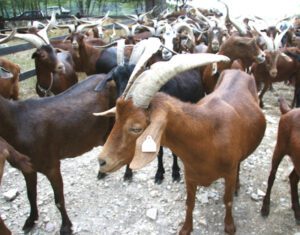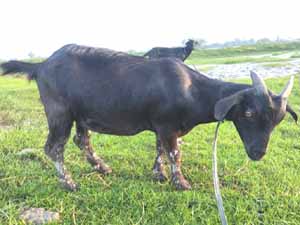Pregnancy and gestation period are almost similar in both sheep and goats. Generally, both of them have about 150 days of gestation period, early fall is their breeding season and they usually give birth of kids in spring.
Although actual gestation period of goats varies, depending on the various types of breed. Goats always show some early signs of pregnancy.
But without proper training, it’s really not easy to detect a pregnant goat and you may need to depend on your vet. But if you learn how to detect pregnancy in goats, then you will be able to confirm that your doe conceived long before the kids arrive.
How To Detect Pregnancy in Goats
In accordance with your vet test, you can also confirm pregnancy by monitoring your doe. Even if you are not an experienced, you can also detect pregnancy in goats by monitoring some of your doe’s reliable physical indicators. However, read more about how to detect pregnancy in goats.
Check by Hand
Touch the belly of your doe. If your doe become pregnant, their belly should feel different than other normal doe. Gently poke the front area of their udder with your finger, if you suspect pregnancy after 6 weeks of breeding.
Generally belly of a pregnant doe will feel tighter if. Although this technique takes long time and some practice for developing.
During the pregnancy period of about 3.5 months, you will feel fetal movement with your hands by pressing the front area of the udder of your doe.
Early Pregnancy Signs
Goats have some early pregnancy signs, through which you can detect pregnancy in goats. Generally, pregnant goats have an increased appetite and they become very calm and quiet.
Their abdomen will begin to swell, usually after 12 weeks. Although some goats have round abdomens. So it will help, if you regularly notice your doe’s abdomen after breeding.
You can suspect your doe is pregnant, if you notice it’s abdomen diameter has increased by more than 1 inch after 6 weeks.
Identify Estrus Cycle
If your doe doesn’t go into an estrus cycle within 3 weeks of having been bred, then it is probably pregnant. This system is easy if you know the doe’s last breeding date.
But difficult for the goats that are raised with males in free grazing system. The doe that are in estrus, become more obvious than natural.
Usually they wag their tail constantly and bleat, which seems that ‘they are in pain’. During this period, they become very aggressive and sometimes attempt to mount other doe.
Milk production can reduced slightly. During this period, the vulva of the doe that have never been bred before become slightly swollen, and due to extra discharge it may look dirty or wet.
Your doe will be more interested in bucks and usually move around them for getting their attention.
Milk Production
You will notice a slight decrease in milk production of your milker doe if they become pregnant. The udder of a pregnant milker doe may look flat and it will swell again in later pregnancy stages (around 15 weeks).
During this stage the body of a doe prepares for feeding her next babies.
Veterinary Detection/Pregnancy Test
You can perform blood or urine test if you are not sure whether your doe is pregnant or not. Perform this type of test after 40 to 50 days of gestation period. Early test may not provide you an accurate result.
You can get a sooner and accurate result if you call a vet. To verify pregnancy, an ultrasound can be performed on your doe after 60 days of gestation period. Another most commonly used method for detecting pregnancy is ultrasounds.
Other Signs of Pregnancy
Some signs of pregnancy in other livestock animals, may not work in caprines. As a result of it, false pregnancy fairly occurs in goats. For an example, udder filling does not mean that a doe is pregnant, even if she is first time mother.
During the third month of a potential pregnancy, you might notice weight gaining in the abdomen of your doe. You might also notice loosening of skin or slight swelling around their vulva, if your doe become pregnant.
The most common and useful system of detecting pregnancy of a doe is probably the absence of it’s estrus cycle. However, practice make perfect.
You will learn more and become more accurate about the pregnancy result if you start raising goats and monitor their activities. Thank you!







I am new in goat keeping venture. I think it’s more than 4 months one of my does is pregnant. When can I expect kidding?
Gestation period of goat is around 150 days. So, you have to wait for a month. Good luck!